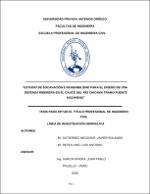Mostrar el registro sencillo del ítem
Estudio de socavación e inundabilidad para el diseño de una defensa ribereña en el cauce del río Chicama tramo puente nazareno
| dc.contributor.advisor | García Rivera, Juan Pablo | |
| dc.contributor.author | Gutiérrez Neciosup, Javier Rolando | |
| dc.contributor.author | Reyes Lino, Luis Antonio | |
| dc.creator | Gutiérrez Neciosup, Javier Rolando | |
| dc.date.accessioned | 2020-11-19T12:18:20Z | |
| dc.date.available | 2020-11-19T12:18:20Z | |
| dc.date.issued | 2020 | |
| dc.identifier.uri | https://hdl.handle.net/20.500.12759/6799 | |
| dc.description.abstract | La presente tesis se desarrolló en el tramo puente Nazareno, tiene como objetivo determinar las zonas de inundabilidad y de estimar la profundidad socavación, posteriormente se realizó el levantamiento topográfico de la zona de estudio identificando sectores críticos calculando la pendiente de 0.56%. Del estudio hidrológico definimos que los caudales se ajustan a la distribución Log Normal 2 parámetros, Log Normal 3 parámetros, Log Pearson tipo III, Gumbel, Log Gumbel, Gamma 2 parámetros, obteniendo el más favorable la distribución Gumbel, el resultado del caudal de diseño es 1154.7 m/s³ para un período de retorno de 170 años con un riesgo admisible de 22% y una vida útil de la defensa ribereña de 40 años. El procedimiento usado para el pre-procesamiento y post-procesamiento fue originar diversas simulaciones para ver cómo se comporta el flujo del río Chicama, con el propósito de determinar algún modelo aplicable para distintos intervalos de tiempo y caudal. Los resultados adquiridos mediante la simulación hidráulica bidimensional con el software Iber 2.4.3, sirvió para establecer el momento de inundación y socavación en épocas de máximas avenidas. Se recomienda para el estudio de la socavación evaluar un período de retorno de 500 años según el por el manual de hidrología, hidrología drenaj | es_PE |
| dc.description.abstract | The present thesis was developed in the Nazareno bridge section, its objective is to determine the floodplain areas and to estimate the scour depth, later the topographic survey of the study area was carried out, identifying critical sectors calculating the slope of 0.56%. From the hydrological study we define that the flows are adjusted to the distribution of the Log Normal 2 parameters, Log Normal 3 parameters, Log Pearson type III, Gumbel, Log Gumbel, Gamma 2 parameters, obtaining the most favorable Gumbel distribution, the result of the design flow it is 1154.7 m / s³ for a return period of 170 years with an admissible risk of 22% and a useful life of the riparian defense of 40 years. The methodology used for the pre-processing and post-processing was to originate various simulations to see how the flow of the Chicama River behaved, in order to determine some applicable model for different time intervals and flow. The results obtained by means of the two-dimensional hydraulic simulation with Iber 2.4.3 software, served to establish the moment of flooding and scour in times of maximum floods. It is recommended for the scour study to evaluate a return period of 500 years according to the manual of hydrology, drainage hydrology | en_US |
| dc.description.uri | Tesis | es_PE |
| dc.format | application/pdf | es_PE |
| dc.language.iso | spa | es_PE |
| dc.publisher | Universidad Privada Antenor Orrego | es_PE |
| dc.relation.ispartofseries | T_ING.CIVIL_1870 | |
| dc.rights | info:eu-repo/semantics/openAccess | es_PE |
| dc.source | Universidad Privada Antenor Orrego | es_PE |
| dc.source | Repositorio institucional - UPAO | es_PE |
| dc.subject | Socavación | es_PE |
| dc.subject | Defensa | es_PE |
| dc.title | Estudio de socavación e inundabilidad para el diseño de una defensa ribereña en el cauce del río Chicama tramo puente nazareno | es_PE |
| dc.type | info:eu-repo/semantics/bachelorThesis | es_PE |
| thesis.degree.grantor | Universidad Privada Antenor Orrego. Facultad de Ingeniería | es_PE |
| thesis.degree.name | Ingeniero Civil | es_PE |
| thesis.degree.discipline | Ingeniería Civil | es_PE |
| dc.subject.ocde | http://purl.org/pe-repo/ocde/ford#2.01.00 | es_PE |
| renati.type | http://purl.org/pe-repo/renati/type#tesis | es_PE |
| renati.level | http://purl.org/pe-repo/renati/nivel#tituloProfesional | es_PE |
| renati.discipline | 732016 | es_PE |
| dc.publisher.country | PE | es_PE |
Ficheros en el ítem
Este ítem aparece en la(s) siguiente(s) colección(es)
-
Ingeniería Civil [1085]

